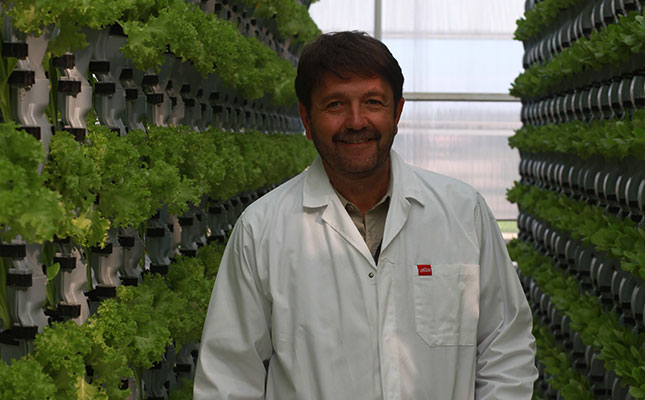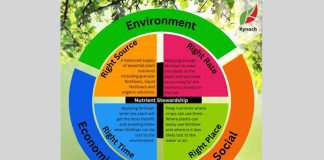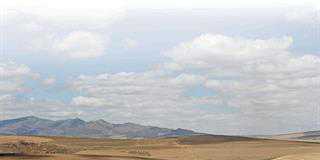
Photo: Gerhard Uys
Faced with climatic uncertainties, dwindling resources and increasing pressure on land, more and more fresh produce farmers worldwide have turned to undercover farming. Its advantages – increased yield, a controlled environment, and efficient water and fertiliser use – have been established for decades, and technologies continually improve.
More recently, undercover farming techniques have expanded to include so-called vertical farming, which requires an even smaller footprint and uses water and fertiliser even more efficiently.
READ Successful, small-scale organic farming in the city
Many vertical farming operations have adopted controlled-environment agriculture (CEA) technology, which allows control of all environmental factors to improve input efficiency. Clean Air Nurseries South Africa (CAN-SA) has further refined water-use efficiency through the design and development of an advanced water-use system called EGGS (Environmental Green Growth System), which utilises ±2 000l water in a four-week production period to produce up to 600kg of lettuce.
Closed-loop water recycling
EGGS aims to save water while producing the highest possible yield per square metre under almost any climatic conditions, and without the aid of petrochemicals to control pathogens. The system operates in a controlled greenhouse chamber, the ICE-AGE (Innovative, Controlled Environment, Accelerated Growth Enhancement), which grows crops in a controlled environment wholly removed from climatic influences.

EGGS, a combination of aeroponics, aquaponics and hydroponics, recycles water in a closed-loop system through vertical growth-tubes between 3m and 6m high in a greenhouse unit. The system utilises ideal growing temperature and humidity control devices to establish a controlled environment. A programmable logic controller (PLC) continuously monitors and corrects pH and electrical conductivity (EC) levels.
The latter indicate the nutrient demands needed for optimal growth. Jan du Plessis, CAN-SA general manager, explains that the EGGS design works optimally with leafy crops such as lettuce, but, with adapted pipes, it can accommodate heavier plants such as strawberries and broccoli.
CSeedlings bought in from external nurseries are treated in quarantine with non-petrochemical products to combat pathogens, fungi and pests. At around two weeks old, plants are moved to the ICE-AGE chamber.
How EGGS works in vertical farming
With EGGS, water is circulated through the growth-tubes to a submerged pump station, where it is analysed and automatically reconditioned to the desired temperature. Air blows through channels in the growth-tubes at a regulated temperature, which creates ideal conditions in and around the biomass growth zone: it controls humidity and supplies an abundance of CO2 (needed for photosynthesis) and O2 (required by the roots).
READ MORE Interested in selling vegetables?
By controlling the micro-climate around the growth zone in vertical farming, and not the entire greenhouse, energy efficiency is maximised. The process is fully automated and utilises remote monitor equipment, smartphone communication and early-warning monitors.
Higher yield, less water
A standard, commercial EGGS unit is 800m² (16m x 50m) in size, and features eight rows, each with 180, 6m-high growth-tubes. Each tube supports 36 lettuce plants, which amounts to 51 840 plants per cycle. At 10 cycles/annum and 250g/plant, total tonnage/annum is about 130t. This is produced with less than 5% water discard.
In traditional farming, a prominent seed distributor recommends 45 000 to 60 000 plants/ha. With three cycles per year, and plants varying between 200g to 300g, farmers typically achieve 40t/ha to 60t/ha per year.
The Agriculture Research Council (ARC) reports that an average of 35t/ha is achieved with traditional farming methods. Less than 60% of this will reach the consumer. “One small (800m²) ICE-AGE chamber equals at least 3ha traditional [outdoor] farming,” Du Plessis explains. According to him, production on 1ha with EGGS equals production on 60ha using traditional farming methods.
System benefits
EGGS uses no soil, herbicides or fungicides, and only a small workforce equipped with high-care personal protective equipment is required to ensure that the plants are free from pests and fungi for the entire cycle. Using EGGS results in vertical farming is an enormous reduction in water use, and no tractors or earthmoving machinery are needed.
The system leaves a small carbon footprint, uses environmentally friendly methodology, and produces plants that are healthier and have a longer shelf-life. While capital expenditure may vary between R7 million and R8 million depending on location, site works and logistics, the return on investment is greater than with traditional farming methods.
Using EGGS, all necessary fertiliser and water additives can be manufactured on site. HClO (hypochlorous acid), Oxi-Lyte (electrolysed saline solution), AOP (advanced oxidation process), H²CO³ (carbonic acid), UV and ozone technologies are utilised for sterilisation and specific fertiliser applications, while ultrasound and luminophores optimise the growth enhancement process.

“We use organic products to reduce the surface tension of water, which aids the osmotic interaction in the plant cells,” explains Du Plessis. “It also aids the capillary action of the plant to absorb water. The main focus is to provide the plant with an abundance of tailor-made nutrients, and correct pH and EC in precision manipulated water at the ideal temperatures.” The system can be also be solar-powered.
A smaller EGGS unit (9m x 6m) is available for hotels and lodges that may struggle to acquire fresh produce. The units are scalable and can be adapted for small-scale and commercial enterprises. These units can be retrofitted to existing greenhouses. According to Du Plessis, EGGS is suitable for crop farming in even the most remote areas and on marginal land. CAN-SA has a small demonstration unit in Pretoria that can be used for experimental purposes.
Clients rent the demonstration unit on contract to determine whether their crops will benefit from using EGGS. The demonstration unit simulates a 2,5ha conventional production system. CAN-SA also provides its clients with training, a standard operating procedure manual, and continued assistance after purchase.
Development
EGGS, co-developed by Gideo van der Merwe, evolved from the results of an experiment conducted to accelerate the growth cycle of algae for the biofuel industry. The E-Smart Food International Group acquired the rights to EGGS, but CAN-SA has retained its licence to sell EGGS units in South Africa.
Currently, the E-Smart Food International Group is constructing a full-scale, state-of-the-art unit in Singapore, to be commissioned later this year. The unit will act as the flagship for the E-Smart Food International Group listing profile.
Symbiotic triangle
CAN-SA considers aquaculture and vermicast essential elements of EGGS, as aquaculture is a rich source of ammonia and fish manure. Damaged leaves and cuttings are recycled as organic nutrients as they are ingested and excreted by earthworms; this benefits the seedlings and mature plants.
Plant roots are dried, mixed and blended with soya, grain and lucerne, and then pelletised as fish food. Bacterial interaction converts fish manure into nitrites, which are then used in the plant fertigation process. Thus, a symbotic triangle between plants, worms and fish is created, while the closed-loop circulation system saves considerable volumes of water and exploits the efficiency of organic fertilisers.
Other applications
EGGS methodologies can enhance traditional irrigation and plant propagation. Food production for intensive sheep-farming and biogas production are areas also currently being explored. Excess biomass and manure is processed through a small bio-reactor. The resulting biogas is utilised as energy for a fishery.
Phone Jan du Plessis on 082 453 4476, or visit cleanairnurseries.co.za.
This article was originally published in the 15 July 2016 issue of Farmer’s Weekly.













